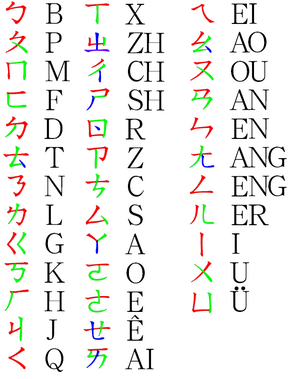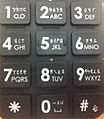Zhuyin facts for kids
Quick facts for kids Bopomofo |
|||||||||||||||||||
|---|---|---|---|---|---|---|---|---|---|---|---|---|---|---|---|---|---|---|---|
| Traditional Chinese | 注音符號 | ||||||||||||||||||
| Simplified Chinese | 注音符号 | ||||||||||||||||||
|
|||||||||||||||||||
Zhuyin Fuhao, often shortened to Zhuyin and commonly called bopomofo, is a special writing system that helps people learn how to pronounce Chinese words. It's like a phonetic alphabet for Chinese. The name "bopomofo" comes from the first four symbols in its traditional order: "bo," "po," "mo," and "fo." These symbols help you understand the sounds of Mandarin Chinese.
Contents
What is Bopomofo?
Bopomofo uses unique symbols that look a bit like parts of older Chinese characters. These symbols are designed to show exactly how each sound in Mandarin Chinese is made. It's different from Pinyin, which uses letters from the English alphabet.
The Bopomofo symbols are divided into two main groups:
- Initials: These are the first sounds in a Chinese syllable. Think of them like the "b" in "ball" or the "m" in "mom."
- Finals: These are the rest of the sounds in a syllable, usually a vowel sound or a combination of vowels and other sounds. For example, the "all" in "ball" or the "om" in "mom."
Bopomofo also uses special marks to show the different tones in Mandarin Chinese. Tones are important because they can change the meaning of a word, even if the sounds are otherwise the same!
History of Bopomofo
How Bopomofo Was Created
Bopomofo was created in China a long time ago. After the Xinhai Revolution in 1911, which led to the overthrow of Puyi, China's last emperor, a new government was formed. This new government wanted to make it easier for everyone to learn to read and write Chinese. So, in 1912, they officially introduced Zhuyin (Bopomofo) as a way to help people learn the sounds of Chinese characters.
Bopomofo in Mainland China and Taiwan
For a while, Bopomofo was used all over China. However, after the Chinese Civil War ended in 1949, the Communist Party of China took control of mainland China. They decided to use a different system called Pinyin, which uses the Latin alphabet (like the English alphabet) to write Chinese sounds. Because of this, Bopomofo is not widely used in mainland China today.
But things were different in Taiwan. The Kuomintang party, which had been defeated in the civil war, moved to Taiwan. They continued to use and teach Bopomofo. Even today, Bopomofo is very important in Taiwan. It's used in schools to teach children how to read and pronounce Chinese characters. Many people in Taiwan also use Bopomofo to type Chinese on their computers and phones!
Images for kids
-
Table showing Bopomofo in Gwoyeu Romatzyh
See also
 In Spanish: Zhuyin para niños
In Spanish: Zhuyin para niños











